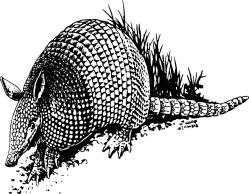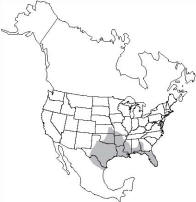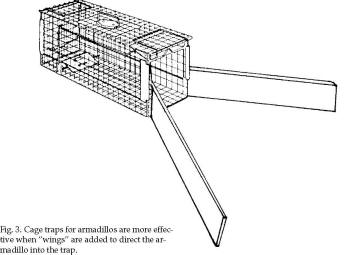|
|
|
|
 |
OTHER MAMMALS: Armadillos |
|
|

Fig. 1. Armadillo,
Dasypus novemcinctus
Identification
The armadillo (Dasypus
novemcinctus) is a rather interesting and unusual
animal that has a protective armor of “horny” material
on its head, body, and tail. This bony armor has nine
movable rings between the shoulder and hip shield. The
head is small with a long, narrow, piglike snout. Canine
and incisor teeth are absent. The peglike cheek teeth
range in number from seven to nine on each side of the
upper and lower jaw. The long tapering tail is encased
in 12 bony rings. The track usually appears to be
three-toed and shows sharp claw marks. The armadillo is
about the size of an opossum, weighing from 8 to 17
pounds (3.5 to 8 kg).
Range
The armadillo ranges from
south Texas to the southeastern tip of New Mexico,
through Oklahoma, the southeastern corner of Kansas and
the southwestern corner of Missouri, most of Arkansas,
and southwestern Mississippi. The range also includes
southern Alabama, Georgia, and most of Florida (Fig. 2).

Fig. 2. Range of the armadillo in North America.
Habitat
The armadillo prefers
dense, shady cover such as brush, woodlands, forests,
and areas adjacent to creeks and rivers. Soil texture is
also a factor in the animal’s habitat selection. It
prefers sandy or loam soils that are loose and porous.
The armadillo will also inhabit areas having cracks,
crevices, and rocks that are suitable for burrows.
Food Habits
More than 90% of the
armadillo’s diet is made up of insects and their larvae.
Armadillos also feed on earthworms, scorpions, spiders,
and other invertebrates. There is evidence that the
species will eat some fruit and vegetable matter such as
berries and tender roots in leaf mold, as well as
maggots and pupae in carrion. Vertebrates are eaten to a
lesser extent, including skinks, lizards, small frogs,
and snakes, as well as the eggs of these animals.
General Biology, Reproduction, and Behavior
The armadillo is active
primarily from twilight through early morning hours in
the summer. In winter it may be active only during the
day. The armadillo usually digs a burrow 7 or 8 inches
(18 or 20 cm) in diameter and up to 15 feet (4.5 m) in
length for shelter and raising young. Burrows are
located in rock piles, around stumps, brush piles, or
terraces around brush or dense woodlands. Armadillos
often have several dens in an area to use for escape.
The young are born in a
nest within the burrow. The female produces only one
litter each year in March or April after a 150-day
gestation period. The litter always consists of
quadruplets of the same sex. The young are identical
since they are derived from a single egg.
The armadillo has poor
eyesight, but a keen sense of smell. In spite of its
cumbersome appearance, the agile armadillo can run well
when in danger. It is a good swimmer and is also able to
walk across the bottom of small streams.
Damage and Damage Identification
Most armadillo damage
occurs as a result of their rooting in lawns, golf
courses, vegetable gardens, and flower beds.
Characteristic signs of armadillo activity are shallow
holes, 1 to 3 inches (2.5 to 7.6 cm) deep and 3 to 5
inches (7.6 to 12.7 cm) wide, which are dug in search of
food. They also uproot flowers and other ornamental
plants. Some damage has been caused by their burrowing
under foundations, driveways, and other structures. Some
people complain that armadillos keep them awake at night
by rubbing their shells against their houses or other
structures.
There is evidence that
armadillos may be responsible for the loss of domestic
poultry eggs. This loss can be prevented through proper
housing or fencing of nesting birds.
Disease is a factor
associated with this species. Armadillos can be infected
by the bacterium Mycobacterium leprae, the causative
agent of leprosy. The role that armadillos have in human
infection, however, has not yet been determined. They
may pose a potential risk for humans, particularly in
the Gulf Coast region.
Legal Status
Armadillos are unprotected
in most states.
Damage Prevention and Control Methods
Exclusion
Armadillos have the
ability to climb and burrow. Fencing or barriers,
however, may exclude armadillos under certain
conditions. A fence slanted outward at a 40o angle, with
a portion buried, can be effective. The cost of
exclusion should be compared to other forms of control
and the value of the resources being protected.
Cultural Methods
Armadillos prefer to have
their burrows in areas that have cover, so the removal
of brush or other such cover will discourage them from
becoming established.
Repellents
None are currently
registered or known to be effective.
Toxicants
None are currently
registered.
Fumigants
None are currently
registered; however, there are some that are effective.
Since state pesticide registrations vary, check with
your local extension office or state wildlife agency for
information on pesticides that are legal in your area.
Trapping
Armadillos can be captured
in 10 x 12 x 32-inch (25 x 30.5 x 81-cm) live or box
traps, such as Havahart, Tomahawk, or homemade types.
The best locations to set traps are along pathways to
armadillo burrows and along fences or other barriers
where the animals may travel.
The best trap is the type
that can be opened at both ends. Its effectiveness can
be enhanced by using “wings” of 1 x 4-inch (2.5 x 10-cm)
or 1 x 6-inch (2.5 x 15-cm) boards about 6 feet (1.8 m)
long to funnel the target animal into the trap (Fig. 3).
This set does not need baiting. If bait is desired, use
overripe or spoiled fruit. Other suggested baits are
fetid meats or mealworms.
Other traps that may be
used are leghold (No. 1 or 2) or size 220 Conibear®
traps. These types should be placed at the entrance of a
burrow to improve selectivity. Care should be taken when
placing leghold traps to avoid areas used by nontarget
animals.
Shooting
Shooting is an effective
and selective method. The best time to shoot is during
twilight hours or at night by spotlight when armadillos
are active. A shotgun (No. 4 to BB-size shot) or rifle
(.22 or other small caliber) can be used. Good judgment
must be used in determining where it is safe to shoot.
Check local laws and ordinances before using shooting as
a control method.

Other Methods
Since most of the damage
armadillos cause is a result of their rooting for
insects and other invertebrates in the soil, soil
insecticides may be used to remove this food source and
make areas less attractive to armadillos.
Economics of Damage and Control
There are few studies
available on the damage caused by armadillos. The damage
they do is localized and is usually more of a nuisance
than an economic loss.
Acknowledgments
Figure 1 from Schwartz and
Schwartz (1981), adapted by Emily Oseas Routman.
Figure 2 adapted from Burt
and Grossenheider (1976) by Jill Sack Johnson.
Figure 3 by Jill Sack
Johnson.
For Additional Information
Chamberlain, P. A. 1980. Armadillos: problems and
control. Proc. Vertebr. Pest Conf. 9:163-169.
Galbreath, G. J. 1982.
Armadillo. Pages 71-79 in J. A. Chapman and G. A.
Feldhamer, eds. Wild mammals of North America: biology,
management and economics. The Johns Hopkins Univ. Press,
Baltimore.
Humphrey, S. R. 1974.
Zoogeography of the nine-banded armadillo (Dasypus
novemcinctus) in the United States. BioSc. 24:457-462.
McBee, K., and R. J.
Baker. 1982. Dasypus novemcinctus. Mammal. Sp. 162:1-9.
Editors
Scott E. Hygnstrom, Robert
M. Tim, Gary E. Larson
PREVENTION AND CONTROL OF
WILDLIFE DAMAGE — 1994
Cooperative Extension
Division Institute of Agriculture and Natural Resources
University of Nebraska -Lincoln
United States Department
of Agriculture Animal and Plant Health Inspection
Service Animal Damage Control
Great Plains Agricultural
Council Wildlife Committee
Special
thanks to:
Clemson University
|